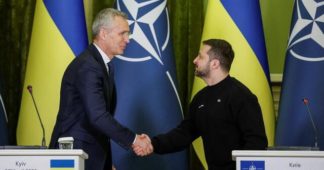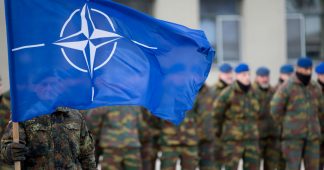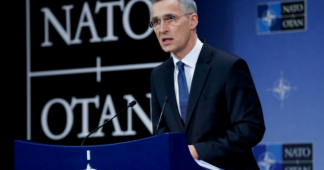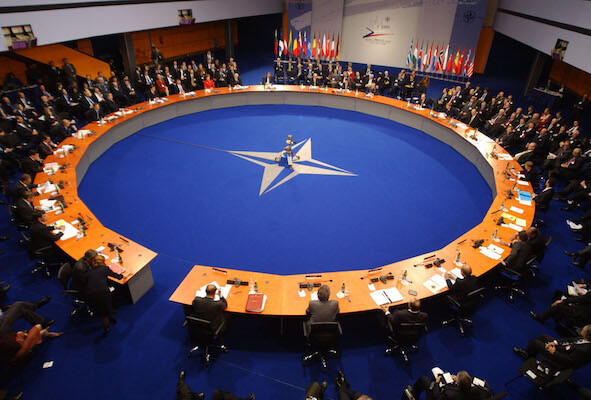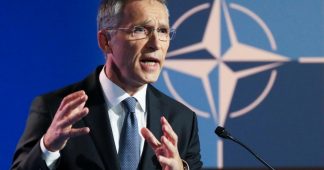By Andre Damon
7 June 2023
On Wednesday, the Guardian published an article in which former NATO Secretary-General Anders Rasmussen raised the prospect that NATO members would deploy “troops on the ground” in Ukraine.
The Guardian described his words as a “striking suggestion that some states may regard the stakes as momentous enough to use their own troops” in the conflict.
Rasmussen was speaking ahead of next month’s NATO summit in Vilnius, Lithuania, where it is expected that NATO will move to adopt some sort of formal military alliance with Ukraine, including potential moves toward NATO membership.
If Ukraine—a country currently at war with Russia—were given formal military guarantees, it would effectively mean that the NATO alliance was formally at war with Russia.
Rasmussen said that if such formal military ties were not established, individual NATO member states would individually expand their own involvement in the war. He said:
“If NATO cannot agree on a clear path forward for Ukraine, there is a clear possibility that some countries individually might take action. We know that Poland is very engaged in providing concrete assistance to Ukraine. And I wouldn’t exclude the possibility that Poland would engage even stronger in this context on a national basis and be followed by the Baltic states, maybe including the possibility of troops on the ground.”
He continued:
“I think the Poles would seriously consider going in and assemble a coalition of the willing if Ukraine doesn’t get anything in Vilnius. We shouldn’t underestimate the Polish feelings, the Poles feel that for too long Western Europe did not listen to their warnings against the true Russian mentality.”
In what can only be read as an endorsement of this possibility, the Guardian paraphrased Rasmussen as saying “it would be entirely legal for Ukraine to seek such military assistance.”
Rasmussen added, “I’ve spoken with several eastern European leaders, and there is a group of hardcore, eastern central European allies that want at least a clear path for Ukraine towards NATO membership.”
Earlier this week NATO foreign ministers met in Oslo, Norway to discuss formalizing their alliance with Ukraine. At the press conference following the conclusion of the meeting, NATO Secretary General Jens Stoltenberg declared, “Our focus today was on how we can bring Ukraine closer to NATO, where it belongs.”
He continued, “All Allies agree that NATO’s door remains open. … Allies agree that Ukraine will become a member of NATO.”
Stoltenberg made clear that formalizing NATO’s alliance structure with Ukraine will be a major focus of the summit.
Possibly responding to Rasmussen’s remarks, US Ambassador to NATO Julianne Smith, told the Guardian: “We are looking at an array of options to signal that Ukraine is advancing in its relationship with Nato.”
These statements come as NATO is carrying out a massive series of military exercises near the Russian border.
Next week, it will launch the largest aerial war games in its history with the Air Defender 23 exercise, in which NATO will fight a simulated war with Russia.
The exercises will involve 250 aircraft, including F-35 fighters and B1 bombers, together with 10,000 troops.
The exercises will take place from the United States to the Baltics and the Black Sea, with Germany playing a leading role.
German Gen. Ingo Gerhartz told the Wall Street Journal, “Germany needs to take much more responsibility and sometimes take the lead among the NATO nations here in Europe … and we prove that we are capable of that in this exercise.”
The presentation of the war games in the Wall Street Journal is chilling:
“The Air Defender exercise will practice the mass deployment of troops and hardware from the U.S. to Europe in response to various scenarios involving Russian attacks on NATO members.
The baseline scenario involves the enemy capturing the German port of Rostock in an attack that would trigger NATO’s common defense clause, known as Article 5. The response will include recapturing the port and other infrastructure, as well as defending cities and moving into offensive action.
Parts of Germany’s airspace will be closed for civilian flights for short intervals. The exercise will also extend into NATO’s eastern flank in the skies over countries such as Lithuania and Romania, as well as Poland and the Czech Republic.
The joint air forces will also practice filling a gap in European security caused by a lack of aerial defense. It will simulate Russian missile and drone attacks and deploy jet fighters to fend them off.”
The escalations come amid a deepening humanitarian crisis caused by the destruction of the Kakhovka dam, which has caused widespread flooding throughout southern Ukraine and worsened an already disastrous humanitarian situation.
Although it is unclear who was responsible for the attack, last year, Ukrainian troops fired on the dam in an attempt to raise water levels downstream, and the military leadership had publicly contemplated destroying it altogether.
In an article published last year profiling Ukraine’s offensive in the Kherson region, the Washington Post reported that Maj. Gen. Andriy Kovalchuk, the leader of Ukraine’s Kherson counteroffensive, “considered flooding the river.”
The Washington Post continued:
“The Ukrainians, he said, even conducted a test strike with a HIMARS launcher on one of the floodgates at the Nova Kakhovka dam, making three holes in the metal to see if the Dnieper’s water could be raised enough to stymie Russian crossings but not flood nearby villages. The test was a success, Kovalchuk said, but the step remained a last resort. He held off.”
On Tuesday, the Post published an article claiming that Ukraine was responsible for the destruction of the Nordstream pipelines in the Baltic Sea on September 26, 2022, and alleging that the United States had advance knowledge of the attack and did nothing to stop it.
Whether as the Post claims, Ukraine carried out the Nordstream bombing with US support, or, as claimed by veteran investigative journalist Seymour Hersh, the United States carried out the attacks directly, it is clear that the United States was involved in the planning of a terrorist attack on its NATO ally, Germany.
It also shows to be completely false the declaration by Secretary of State Antony Blinken that “I really have nothing to say to the absurd allegation from President Putin that we or other partners or allies are somehow responsible” for the Nordstream bombing.
We remind our readers that publication of articles on our site does not mean that we agree with what is written. Our policy is to publish anything which we consider of interest, so as to assist our readers in forming their opinions. Sometimes we even publish articles with which we totally disagree, since we believe it is important for our readers to be informed on as wide a spectrum of views as possible.

